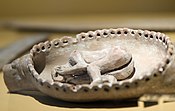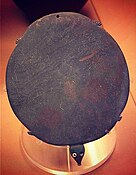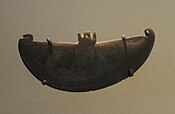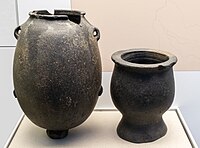Amratian culture
Naqada II (Gerzeh culture) |
The Amratian culture, also called Naqada I, was an archaeological culture of prehistoric Upper Egypt. It lasted approximately from 4000 to 3500 BC.[2]
Overview
The Amratian culture is named after the archaeological site of
Trade between the Amratian culture bearers in Upper Egypt and populations of Lower Egypt is attested during this time through new excavated objects. A stone vase from the north has been found at el-Amrah. The predecessor Badarian culture had also discovered that malachite could be heated into copper beads;[a] the Amratians shaped this metal by chipping.[6] Obsidian and a very small amount of gold were both imported from Nubia during this time.[3][4] Trade with the oases also was likely.[3] Cedar was imported from Byblos, marble from Paros, as well as emery from Naxos.[6]
New innovations such as adobe buildings, for which the Gerzeh culture is well known, also begin to appear during this time, attesting to cultural continuity. However, they did not reach nearly the widespread use that they were known for in later times.[7] Additionally, oval and theriomorphic cosmetic palettes appear to be used in this period. However, the workmanship was still very rudimentary and the relief artwork for which they were later known is not yet present.[8]
Each Amratian village had an animal deity; amulets were worn of humans and various animals including birds and fish. Food, weaponry, statuettes, decorations, malachite, and occasionally dogs were buried with the deceased.[6]
-
Ovoid Naqada I (Amratian) black-topped terracotta vase, c. 3800–3500 BC
-
Clay model of four head of cattle, c. 3500 BC, found at El-Amrah
-
Clay figure, Egypt Naqada I period, circa 4000 BC. RMO Leiden
-
Egyptian disk-shapedmacehead, 4000–3400 BCE. At the end of the period, it was replaced by the superior Mesopotamian-style pear-shaped macehead, as seen on the Narmer Palette.[9]
Early cosmetic palettes
Siltstone was first utilized for cosmetic palettes by the
-
Mudstone cosmetic palette in the form of a turtle with inlaid bone eyes (one missing). Predynastic, Naqada I. 4000–3600 BC. EA 37913 (British Museum)
-
Mudstone palette in the form of a hippopotamus. Predynastic, Naqada I. 4000–3600 BC. EA 29416. (British Museum)
-
Naqada I–II palette for blending cosmetics
-
Palette in the shape of a boat, 3700–3600 BC, Naqada I
Bearded figurines
Many figurines are known from Naqada I, which were carved on animal tusks. The figurines usually have pointed beards, and some trace of hair.
-
Figurine of a bearded man by the , France)
-
Hippopotamus tusk with carved head of a bearded man with torus-like headgear, LateNaqada II, 3800–3400 BC. Brooklyn Museum.[11]
-
Hippopotamus tusk with carved head, 3800–3400 BCE, Naqada I–II
-
Figurine,Ägyptisches Museum Berlin
Other artifacts
-
Lower-Egypt basalt jars in the shape of pottery from Maadi, Naqada I–II, British Museum EA 34398, EA 26654
Relative chronology
See also
- 5.9 kiloyear event
- Prehistoric Egypt
References
Footnotes
- ^ Copper may have also been imported from the Sinai Peninsula or perhaps Nubia.
Citations
- ^ Hendrickx, Stan. "The relative chronology of the Naqada culture: Problems and possibilities [in:] Spencer, A.J. (ed.), Aspects of Early Egypt. London: British Museum Press, 1996: 36-69": 64.
{{cite journal}}: Cite journal requires|journal=(help) - ISBN 0-19-815034-2.
- ^ ISBN 0-631-17472-9.
- ^ a b Gardiner, Alan (1964). Egypt of the Pharaohs. Oxford: University Press. p. 390.
- ^ Newell, G.D. (2012). The relative chronology of PNC I. A new chronological synthesis for the Egyptian Predynastic. ex.cathedra Press.
- ^ ]
- ISBN 0-691-03606-3.
- ^ Gardiner, Alan (1964). Egypt of the Pharaohs. Oxford: University Press. p. 393.
- ISBN 978-0-8061-3342-3.
- ^ ISBN 978-90-429-1469-8.
- ^ ISBN 978-90-429-1469-8.




![Egyptian disk-shaped macehead, 4000–3400 BCE. At the end of the period, it was replaced by the superior Mesopotamian-style pear-shaped macehead, as seen on the Narmer Palette.[9]](http://upload.wikimedia.org/wikipedia/commons/thumb/9/93/Egyptian_disk_macehead_4000-3400_BCE.jpg/175px-Egyptian_disk_macehead_4000-3400_BCE.jpg)





![Hippopotamus tusk with carved head of a bearded man with torus-like headgear, Late Naqada I – Early Naqada II, 3800–3400 BC. Brooklyn Museum.[11]](http://upload.wikimedia.org/wikipedia/commons/thumb/8/83/Hippopotamus_Tusk_with_Carved_Head_Naqada_I-II_%28detail%29.jpg/144px-Hippopotamus_Tusk_with_Carved_Head_Naqada_I-II_%28detail%29.jpg)



